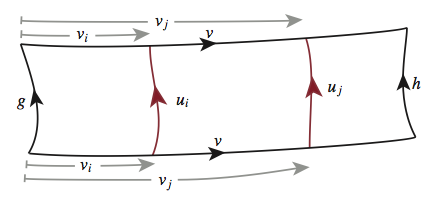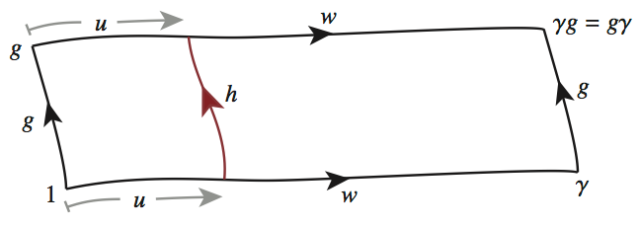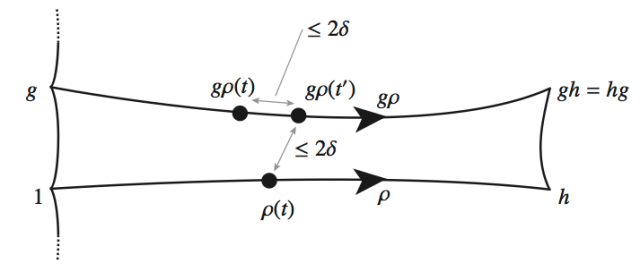Our main source for this post is Bridson and Haefliger’s book [BrH].
However, the material has origins in
- Alonso, T. Brady, Cooper, Ferlini, Lustig, Mihalik, Shapiro and Short (also ed.),
- Gersten and Short,
- Ghys and de al Harpe, Sur les groupes hyperboliques d’après Mikhael Gromov, Progr. Math., 83, Birkhauser, 1990, (partial English translation here),
- Gromov, Hyperbolic groups, Essays on group theory, MSRI series vol. 8, Springer–Verlag, 1987,
- Short, Regular subgroups of automatic groups, MSRI preprint no. 07723–89, 1989.
We’ve completed our overview of the landscape of non–positively curved groups and now turn to the primary subject of this blog — the subgroups. We’ve promised “Here there be dragons!” — but first we’ll cast an eye over the tamer inhabitants. In this post and the next we’ll describe contexts where the subgroup structure can be said to be well–behaved.
We begin here with hyperbolic groups, where the crucial notion in the study of “well–behaved” subgroups was identified by Gromov (Hyperbolic groups, Essays on group theory, MSRI series vol. 8, Springer–Verlag, 1987) as being quasi-convexity.
Quasi–convexity
Here is how the the usual definition of convexity is “quasifyied”.
Definition. A subspace of a geodesic metric space
is quasi–convex when there exists some
such that every geodesic in
that connects a pair of points in
lies inside the
–neighbourhood of
.
Definition. Suppose is a group with finite generating set
. A subgroup
of a group
is quasi–convex if it’s quasi-convex in the Cayley graph
.
For hyperbolic groups, this does not depend on .
Lemma 1. Suppose is a group with finite generating set
and that
is a
–quasi-convex subgroup of
. Then
is finitely generated and the inclusion
is a quasi–isometric embedding.
Proof: Let be set of all elements of
a distance at most
from
in
. We claim that
.
Suppose is a geodesic edge–path in
from
to an element
of
. Consider inserting detours into the path
: on arriving at each successive vertex travel to a nearest element of
and then back. By the quasi–convexity of
, each detour has length at most
. So our new path is a concatenation of at most
paths each of which travels between elements of
and has length at most
— see below.
That is a quasi–isometric embedding follows from
Distortion and chacterizing quasi–convexity in hyperbolic groups
Definition. The distortion of a finitely generated subgroup
in a finitely generated group
, is defined by
Here and
denote word metrics associated to some choices of finite generating sets. Those choices are not important: different choices lead to
–equivalent distortion functions.
Definition. is undistorted in
when there exists
such that
for all
.
Lemma 2. For a finitely generated subgroup of a hyperbolic group
, the following are equivalent.
is quasi–convex,
- the inclusion
is a quasi-isometric embedding,
is undistorted in
.
Proof: Lemma 1 gives 1 2. For 2
1, note that a geodesic in the Cayley graph of
(with respect to some finite generating set) connecting a pair of elements
maps to a quasi-geodesic connecting them in the Cayley graph of
(with respect to some finite generating set) since
is a quasi-isometric embedding. But, as
is
–hyperbolic, that quasi–geodesic is close to any geodesic connecting
to
(as we’ve previously discussed), and so any geodesic in the Cayley graph of
between
and
is in some uniform neighbourhood of
. For 2
3, unravel the definitions to see they are two ways of expressing the same condition.
Quasi–convex subgroups are hyperbolic
Theorem 1. Quasi–convex subgroups of hyperbolic groups are hyperbolic.
Proof: The work for this was done in Lemma 2. Suppose is a quasi–convex subgroup of a hyperbolic group
. A geodesic triangle
in (a Cayley graph of)
becomes a quasi–geodesic triangle in (a Cayley graph of)
, since
is a quasi-isometric embedding. But in
–hyperbolic spaces, quasi–geodesic are uniformly close to geodesics and geodesic triangles are
–thin, so
is uniformly thin in
and hence also in
.
The converse to Theorem 1 is false. As we’ll see in some future post (e.g. on Cannon–Thurston maps or on hydra groups), there are hyperbolic (finite rank free, indeed) subgroups of hyperbolic groups that are heavily distorted.
Applications of quasi–convexity
The applications we will draw are that is never a subgroup of a hyperbolic group and that
subgroups are always undistorted.
First we need:
Lemma 3 (adapted from [BrH], pages 476–477). If and
are
–quasi-convex subgroups of a group
with finite generating set
, then their intersection is quasi–convex.
Proof: Let denote the word metric on
with respect to
. Let
We will show that is
–quasi–convex. It is enough to prove that if
is a geodesic word on
representing an element of
and
is a prefix of
, then
represents an element of
a distance at most
from
.
Let be the set of words
such that
and for every prefix
of
, the group element represented by
is a distance at most
from each of
and
. This set is non–empty as one could take
to be the suffix of
such that
as words.
Let be a minimal length word in
. We claim that
, which will complete the proof of the lemma. Well, suppose
and
are prefixes of
and
, for
, are group elements with
such that
represent elements of
. Suppose
— then, as words,
and
for some words
and
. If
, then
would be a shorter word than
in
. So, as there are at most
possibilities for the pairs
, the length of
is at most
.
Incidentally, our next lemma implies the Conjugacy Problem is decidable in hyperbolic groups. (In fact, it also works in semi–hyperbolic groups.)
Lemma 4. Suppose is a hyperbolic group and
denotes the word metric on
with respect to finite generating set
. Then there is a constant
such that if
and
are conjugate elements in
and
, then there is a word
such that
in
and
.
Proof: Let be a minimal length word such that
in
. Let
denote the length–
prefix of
, and let
be a minimal length word such that
in
. (See below.) The words
and
must be different for all
between
and
, as otherwise we could find a word
shorter than
such that
: if
and
as words, then take
.
By the convexity of the metric, there is a constant , depending only on
and
such that
for all
. But there are no more than
words of length at most
, which proves the lemma.
Proposition 1. (adapted from [BrH], pages 477–478). The centralizer of any element
in a hyperbolic group
is quasi-convex.
Proof: Fix a finite generating set for
. Suppose
is represented by a geodesic word
and
is a prefix of
. We aim to show that there is a constant
, depending only on
,
and
such that the group element represented by
is within distance
from
.
Let . By applying the convexity of the metric to the geodesic rectangle displayed below, we learn there is some constant
depending only on
and
such that
.
By definition, and
are conjugate. Let
be a minimal length word such that
. Note that
because
Applying Lemma 4 together with the inequality , we get an upper bound,
which depends only on ,
and
. Thus
is distance at most
from
.
Another way of stating the conclusion of the next theorem is that the subgroups are bi–infinite quasi–geodesics.
Theorem 2 (adapted from [BrH], page 462). subgroups of a hyperbolc group are quasi-convex.
Proof: Suppose is an element of infinite order in a hyperbolic group
. By Proposition 1,
is quasi–convex, and so, by Theorem 1, is hyperbolic and, in particular, finitely generated. Its centre
is the intersection of the centralizers of each of the elements of a finite generating set, so is itself quasi–convex, by Lemma 3. So
is hyperbolic by Theorem 1. But
is abelian and hyperbolic abelian groups and either finite or virtually
. As
contains
, it must be virtually
.
Now the inclusions
are all quasi-isometric embeddings: the first because is of finite index in
, and the second and third by Lemma 2. So the composition
is a quasi-isometric embedding, and therefore
is quasi–convex by Lemma 2.
The theorem above means many non–abelian solvable groups cannot be subgroups of hyperbolic groups — they have distorted subgroups on account of calculations such as the following.
Lemma 5. If elements and
of a group satisfy the relation
for some integers
and
, then they satisfy
for all integers .
Proof: Induct on :
The following proposition appears in Gromov’s original article on hyperbolic groups, but his proof is very different: he defines and analyzes the boundary of .
Proposition 2 (adapted from [BrH], page 462). If is an infinite order element of a hyperbolic group
, then
is a finite index subgroup of its centralizer
.
Proof: Fix a finite generating set for
and a
such that
is
–hyperbolic. Lemma 5 implies that the positive powers of
are in distinct conjugacy classes since if
for some
and some integers
and
with
, then
and would fail to be a quasi–isometric embedding. So, by replacing
with a power if necessary, we may assume
is not conjugate to an element of
within a distance
from
.
Now suppose . We aim to show that
where
, which will suffice to prove the proposition. We will suppose otherwise and seek a contradiction.
Suppose . By replacing
by
(which is also in
) we can assume
.
Let be a geodesic edge–path in
from
to
, parametrized proportional to arc–length — so
is a distance
from
. The translate
is a geodesic edge–path from
to
. Consider a geodesic rectangle which has
and
as two of its sides:
The fact that geodesic triangles in are
–thin implies that for all
, the point
is within a distance
from one of the other three sides of the rectangle. The assumption that
allows us to choose a
for which that other side must be
— that is, there is some
such that
. But
and
, so
. And therefore,
.
Let be a group element (i.e. a vertex) on
closest to
. Then
and so
, which is a contradiction.
As an immediate consequence of Proposition 2, we have:
Theorem 3. Abelian subgroups of hyperbolic groups are either finite or virtually . In particular,
is never a subgroup of a hyperbolic group.




